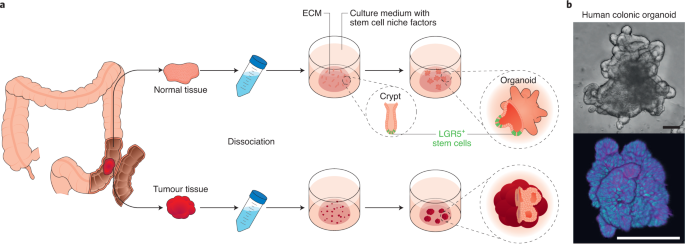
HUMAN DERIVED ORGANOIDS TO STUDY INFECTION BIOLOGY
A human model system is preferable to animal models when studying infectious diseases pathogenesis because pathogens often have a narrow species or tissue tropism, meaning that they infect only certain species and sometimes certain cell types.
For decades there were not any methods to culture human noroviruses which cause acute gastroenteritis and can be fatal in young children’s or in old individuals. (1)
ORGANOIDS TO STUDY VIRUSES
It has recently become possible to successfully grow virus in culture by using a human intestinal organoid-derived epithelial monolayer, which led to the finding that certain viral strains specifically require both certain bile components and the activity of host galactoside 2-aplha-l-fucosyltransferases 2, an enzyme responsible for infections (2), which mirrors the patterns of epidemiological studies.
Human airway organoids are suitable models for the study of respiratory viruses. Respiratory syncytical virus (RSV) is a single-stranded RNA virus that is significant threat to young infants and the elderly. (3)
It was also shown to successfully infect human airway organoids and to cause dramatic changes to epithelial morphology and function. The human airway organoid system has also been used to assess the infection of animal borne influenza viruses. (4) the diversity of two viral surface molecules- hemagglutinin and neuraminidase-has previously made it difficult to predict the infectivity of these viruses in humans. (5) The human airway organoids faithfully simulate human airway epithelium, and provide a platform for rapidly testing the infectivity of new emerging influenza viruses.
REFERENCES:
1. Ramani, S., Atmar, R. L. & Estes, M. K. Epidemiology of human noroviruses and updates on vaccine development. Curr. Opin. Gastroenterol. 30, 25–33 (2014).
2. Ettayebi, K. et al. Replication of human noroviruses in stem cell-derived human enteroids. Science353, 1387–1393 (2016). Ettayebi et al. demonstrate that organoid culture systems can support research on difficult pathogens that previously could not be cultivated.
3. Sachs, N. et al. Long-term expanding human airway organoids for disease modeling. EMBO J. 38, e100300 (2019).
4. To, K. K., Chan, J. F., Chen, H., Li, L. & Yuen, K. Y. The emergence of influenza A H7N9 in human beings 16 years after influenza A H5N1: a tale of two cities. Lancet Infect. Dis. 13, 809–821 (2013).
5. McAuley, J. L., Gilbertson, B. P., Trifkovic, S., Brown, L. E. & McKimm-Breschkin, J. L. Influenza virus neuraminidase structure and functions. Front. Microbiol. 10, 39 (2019).



